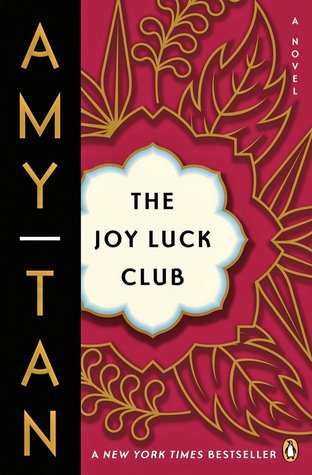 Title: The Joy Luck Club
Title: The Joy Luck Club
Author: Amy Tan
1st Date of Publication: 1989
1st Date of Publication: 1989
ISBN: 978014303809
# of Pages: 408
# of Pages: 408
Genre: Historical Fiction
Age Rating: 13
Book Description:
In 1949 four Chinese women, recent immigrants to San Francisco, begin meeting to eat dim sum, play mahjong, and talk. United in shared loss and hope, they call themselves the Joy Luck Club. With wit and wisdom, Amy Tan examines the sometimes painful, often tender, and always deep connection between these four women and their American-born daughters. As each reveals her secrets, trying to unravel the truth about her life, the strings become more tangled, more entwined.
Setting: 1940s in San Francisco, California
Point of View: 1st person- 7 female characters
In 1949 four Chinese women, recent immigrants to San Francisco, begin meeting to eat dim sum, play mahjong, and talk. United in shared loss and hope, they call themselves the Joy Luck Club. With wit and wisdom, Amy Tan examines the sometimes painful, often tender, and always deep connection between these four women and their American-born daughters. As each reveals her secrets, trying to unravel the truth about her life, the strings become more tangled, more entwined.
Setting: 1940s in San Francisco, California
Point of View: 1st person- 7 female characters
Goodreads Rating: 3.89
My Rating: 4.0
Part of the Book that Caught My Attention: Cover
View on the Cover: I love the flower on the cover. It is very intricate and beautiful. The color red with the gold and black go well together, but it does not really tell you much about the book.
View on Title: What brings joy? What about luck? What does the club consist of? Who is in it or how does one get into this club?
View on Title: What brings joy? What about luck? What does the club consist of? Who is in it or how does one get into this club?
Pros:
- There is a glimpse of Chinese culture and Chinese-American culture. It allows a deeper appreciation for Chinese culture as the mothers try to show their daughters where they came from.
- There is 7 different perspectives but it flows so well from one character to another.
- The mother-daughter relationships are very real. The reader is able to see how the daughters mature even as mid-30 year olds.
- It's historical fiction and talks about life during WWII in China and follows through the baby boomers' lives in the United States.
- Many of the female characters correlate even if they are not related. It shows that no one is truly alone. This theme is seen even at the mah jong table when Jing-mei "June" Woo joins in place of her mother after her mother's death.
Cons:
- There are so many characters with Chinese names that it is a little difficult to understand who is who at first.
- I wish it was longer because it continued to get more interesting. It made me wanting more.
Critics' Reviews
"Intensely poetic, startlingly imaginative and moving, this remarkable book will speak to many women, mothers and grown daughters, about the persistent tensions and powerful bonds between generations and cultures. The narrative voice moves among seven characters. Jing-mei "June" Woo recounts her first session in a San Francisco mah-jong club founded by her recently dead, spiritually vital, mother. The three remaining club members and their daughters alternate with stories of their lives, tales that are stunning, funny and heartbreaking. The mothers, all born in China, tell about grueling hardship and misery, the tyranny of family pride and the fear of losing face. The daughters try to reconcile their personalities, shaped by American standards, with seemingly irrational maternal expectations. "My mother and I never understood each other; we translated each other's meanings. I talked to her in English, she answered back in Chinese," says one character. A crippling generation gap is the result: the mothers, superstitious, full of dread, always fearing bad luck, raise their daughters with hope that their lives will be better, but they also mourn the loss of a heritage their daughters cannot comprehend. Deceptively simple, yet inherently dramatic, each chapter can stand alone; yet personalities unfold and details build to deepen the impact and meaning of the whole. Thus, when infants abandoned in China in the first chapter turn up as adults in the last, their reunion with the one remaining family member is a poignant reminder of what is possible and what is not. On the order of Maxine Hong Kingston's work, but more accessible, its Oriental orientation an irresistible magnet, Tan's first novel is a major achievement." --Publishers Weekly
"The "joy luck club" is a mah jong/storytelling support group formed by four Chinese women in San Francisco in 1949. Years later, when member Suyuan Woo dies, her daughter June (Jing-mei) is asked to take her place at the mah jong table. With chapters alternating between the mothers and the daughters of the group, we hear stories of the old times and the new; as parents struggle to adjust to America, their American children must struggle with the confusion of having immigrant parents. Reminiscent of Maxine Hong Kingston's The Woman Warrior in its vivid depiction of Chinese-American women, this novel is full of complicated, endearingly human characters and first-rate story telling in the oral tradition. It should be a hit in any fiction collection." --Library Journal
Other Recommendations:
Children of Willesden Lane by Mona Golabek
The Girl Who Played Go by Shan Sa
The Girl Who Played Go by Shan Sa
No comments:
Post a Comment